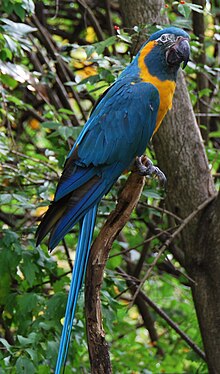| Blue-throated macaw | |
|---|---|

| |
| At Cincinnati Zoo and Botanical Garden, Ohio, USA | |
| Scientific classification | |
| Domain: | Eukaryota |
| Kingdom: | Animalia |
| Phylum: | Chordata |
| Class: | Aves |
| Order: | Psittaciformes |
| Family: | Psittacidae |
| Genus: | Ara |
| Species: | A. glaucogularis
|
| Binomial name | |
| Ara glaucogularis Dabbene, 1921
| |

| |
| Distribution range | |
| Synonyms | |
| |
The blue-throated macaw (Ara glaucogularis), also known as the Caninde macaw or Wagler's macaw,[3] is a macaw endemic to a small area of north-central Bolivia, known as Los Llanos de Moxos. In 2014 this species was designated by law as a natural patrimony of Bolivia.[4] Until 2010, it was hunted by native people to make feathered "Moxeño" headdresses for "machetero" ritual dances.[5]
Recent population and range estimates suggest that about 208–303 adult individuals remain in the wild.[6] Its demise was brought upon by nesting competition, avian predation, and a small native range, exacerbated by indigenous hunting and capture for the pet trade.[7] Current threats continue to include hunting and trapping as well as tree cutting, invasive species, disease, and use of powders or foams used to extinguish fires.[6] It is listed as Critically Endangered by the IUCN in the wild and is protected by trading prohibitions.[8]
The name "Wagler's macaw" is in honor of German herpetologist and ornithologist Johann Georg Wagler, who processed many of Johan Baptist von Spix's Brazilian collections at the Ludwig Maximilian University of Munich, and first described the blue macaws for a European readership in Monographia Psittacorum (1832).
- ^ BirdLife International. (2021). "Ara glaucogularis". IUCN Red List of Threatened Species. 2021: e.T22685542A196624397. doi:10.2305/IUCN.UK.2021-3.RLTS.T22685542A196624397.en. Retrieved 12 November 2021.
- ^ "Appendices | CITES". cites.org. Retrieved 2022-01-14.
- ^ "Ara glaucogularis". Retrieved 26 February 2014.
- ^ "Ley Nº 584 – Declara Patrimonio Natural del Estado Plurinacional de Bolivia, a la Paraba Barba Azul (Ara glaucogularis)". www.ecolex.org (in Spanish). Archived from the original on 2017-12-22. Retrieved 2017-12-20.
- ^ "Six thousand macaws saved by Armonía's alternative feather program". Armonía Bolivia. 24 September 2016. Archived from the original on 2 October 2016. Retrieved 11 February 2020.
- ^ a b "Endangered and Threatened Wildlife and Plants; Listing the Blue-throated Macaw". The IUCN Red List of Threatened Species. 12 February 2021. Retrieved 20 March 2023.
- ^ "Endangered and Threatened Wildlife and Plants; Listing the Blue-throated Macaw". Federal Register. 3 October 2013. Retrieved 11 February 2020.
- ^ Cite error: The named reference
birdlife-1548was invoked but never defined (see the help page).
